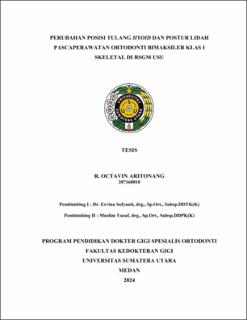| dc.description.abstract | Introduction: Bimaxillary protrusion treatment often involves premolars extraction.
Tooth extraction can reduce the length of the arch and oral cavity, as the post
extraction space is used for incisor retraction. The incisors retrusive position will
change the dental arch and skeletal dimensions causing changes in tongue posture
become more posterior, and narrowing of the oropharynx. Objectives: To determine
the changes in hyoid bone position and tongue posture after bimaxillary class I skeletal
orthodontic treatment at RSGM USU. Materials and Methods: This study used before
and after cephalometric radiograph samples from 20 orthodontic patients aged 17-40
years. The study used a retrospective cohort design. The Shapiro-Wilk normality test
stated that the variables H-PTR, H-Sper, H-C3CHor, Haxis-PTR were not normally
distributed so the Wilcoxon test was used, while other data used the t-paired test.
Results: The largest change in hyoid position in the linear direction is H-PTR, which
is backward by 1.840 ± 4.277 (mm). The smallest was the G-C3CHor distance, which
increased by about -0.498 ± 4.552 (mm). The position in the angular direction is largest
at the Haxis-PTR angle is 2.282 ± 10.388 (mm), the smallest is the Haxis-C3CHor
angle is -0.142 ± 5.946 (mm). The tongue length shortens by 3.239 ± 7.649 (mm).
Tongue height decreased by 0.177 ± 3.757 (mm). UI-APog, UI-PP, LI-APog, LI-FH
had significant changes (p<0.05). Conclusion: There were no significant changes in
hyoid position, tongue posture, and anterior retroclination in linear and angular
directions. There were significant differences in anterior retroclination in the linear
and angular directions before and after treatment. | en_US |


